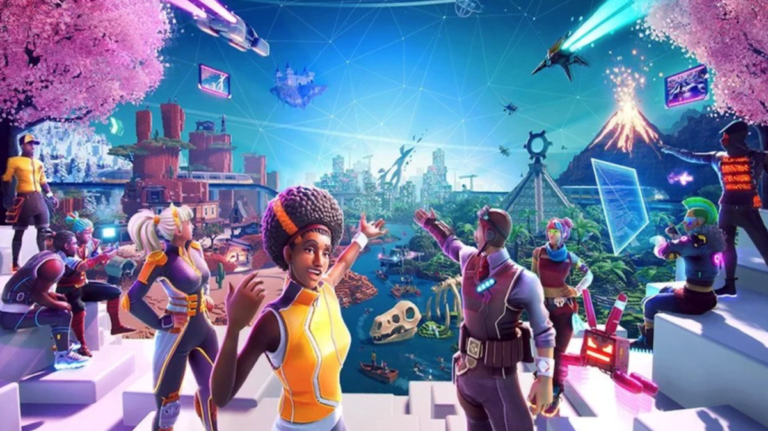The Metaverse and Ecommerce: Merchant’s Dream, Consumer’s Paradise

Ecommerce is growing increasingly ubiquitous, with one in four people on the planet shopping online now. With this in mind, and the metaverse twinkling on our horizon, e-commerce is set to enter a transformative period.
The rise of ecommerce, with its intrinsic ease and convenience, is steadily surpassing the physical bricks-and-mortar shopping we once loved.
Sure, it’s lovely to go shopping with friends and be greeted with real smiles and the human touch. Yet, how often do we experience real smiles and a high quality of customer service, anyway?
The reality is, going to buy something can be a strenuous, uncomfortable activity, takes large chunks of your valuable time and is often quite unpleasant – especially when you’re caught in the chaos of weekend shopping.
Hence, the era of ecommerce has removed much of this burden. Enter a virtual shop and a few clicks later, on a highly-optimized website or application, you’re done. Your shopping is on the way and you haven’t broken a sweat doing it.
Enter the metaverse, which is arriving at the perfect time when a convergence of technological innovations, such as virtual reality (VR) and augmented reality (AR), are revolutionizing our customer experience.
Now, as we reach new frontiers of immersion in our digital shopping journey, the metaverse will build a bridge between the physical and virtual experiences we enjoy.
Indeed, the human touch will be addressed in the metaverse. We will be greeted with personalized experiences in an immersive 3D virtual environment, with friendly avatars assisting our needs and we’ll be able to do our shopping online with friends.
We will navigate various virtual islands from the comfort of our chair, searching for products in a sea of tranquility, surrounded by an ocean of possibilities.
You may be thinking: what a minute, the metaverse doesn’t exist yet! Indeed, we’re not there yet. We’re far from reaching a seamless, interoperable virtual world, which allows us the freedom to explore 3D environments unrestricted.
As of now, the metaverse is currently under construction. We know that many major companies are heavily invested in the metaverse, such as Mark Zuckerberg and Meta. Moreover, we know a little about what is being visualized, we’ve seen the Meta and Microsoft video teasers.
It would be more realistic to say that we’re in the metaverse development phase. We’re entering an era of increased presence and interaction with our favourite brands online. Hence, in the coming months and years, we’re going to experience an entirely new virtual world, characterized by exponential technologies like virtual reality, augmented reality, and non-fungible tokens (NFTs).
Brands are starting to recognize the opportunities they have in the metaverse. If the era of the internet and social media has been transformative for brands, imagine what brands can do in immersive 3D virtual worlds, with increased presence and realism.
Gucci built the Gucci Garden on Roblox last year, a 14-day experience on the popular gaming platform, which was a brilliant insight into the future of ecommerce. The virtual garden replicated their Gucci Garden in the real world and created a visually stunning exhibition, which also had a Gucci Store, where you could buy limited-edition, digital wearables for your avatar. A virtual Gucci bag sold for over $4,000 USD.
Similarly last year, Sephora achieved a virtual event called ‘SEPHORiA: House of Beauty’, which invited guests to their “virtual 3D game-like environment featuring an interactive beauty “house” with multiple rooms to explore”. For example, the ‘family room’ allowed for community interaction and discussions with brand leaders in the industry.
These examples are just the tip of the iceberg as we approach an unprecedented consumer experience in the digital world – powered by breathtaking advancements in technology.

Gamification of e-commerce
At the forefront of the metaverse, e-commerce revolution will be built-in gaming experiences.
Charlotte Tilbury, a popular skincare and make-up brand, created a VR online store in 2020, then built upon this experience with “Shop With Friends” in 2021. This new function, available on desktop and mobile, allowed users to invite their friends into the virtual store and enjoy an interactive, 3D shopping experience together.
What is more, Charlotte Tilbury built in a gaming function, which invited customers to search for hidden keys in the store. Thus, customers had a reason to stay there longer and hang out in the virtual store. As we’ve seen in popular games like Fortnite and Roblox, playing games is both highly addictive and inspires players to spend money. Once brands can perfect this gamification in the metaverse and build meaningful experiences into their virtual stores, they will reap the rewards.
Games will be all around us in the metaverse, as we traverse various platforms with our own, personalized 3D avatars. Retailers will inevitably create enticing schemes or activities to keep us locked into their worlds. In the past, retailers have inspired us to return to their stores via loyalty point systems. Now, imagine the possibilities when you can build your own virtual 3D experience for customers, which is personalized.
Louis Vuitton made its entry to the metaverse by creating ‘Louis: The Game’. In this experience, you explore six different worlds with the protagonist, Vivienne, where she needs to collect 200 candles to commemorate the birthday of Louis Vuitton.
Recently, they added two new expansion levels to the game, allowing players to collect ten new NFTs (non-fungible tokens) as they travel through a virtual world, learning about the rich history of Louis Vuitton. This brand indulgence in gaming is highly calculated and allows the brand to tap into a previously untapped demographic: the Gen Z consumers.
Furthermore, this experimentation with NFTs is only the beginning for big brands.
E-commerce with NFTs
NFTs will pave the way for the metaverse economy and eCommerce will benefit significantly from this technology. The NFT craze started with digital art collectibles last year, but now we’re starting to get a glimpse of the possibilities as brands engage with them more.
First of all, NFTs are highly dynamic and can have multi-faceted utility in the real world and digital world. As digital tokens stored on a transparent blockchain, with an underlying, irreversible code, creators can build in any utility for them their imagination desires.
This has to be a dream from a merchant’s point of view. They can build hype about a product with an NFT launch, assign levels of rarity to create a surging demand and collaborate with trendy, cool artists who have their own following.
What is more, as the creator of an NFT, you can write into the ‘smart contract’ (underlying code) physical world and virtual world benefits, building a bridge between the two spheres.
Retail brands recognizing NFTs
Nike recognized the potential of this technology when they bought RTFKT Studios last year, who are creators of stylish virtual sneakers and wearables for the metaverse.
RTFKT Studios famously launched an NFT collection which merged realities, allowing customers to redeem real, physical sneakers as well as digital sneakers. From this launch, RTFKT Studios made $3.1 million USD as the collection sold out in seven minutes.
Nike’s debut collaboration with RTFKT Studios, entitled ‘RTFKT x Nike Dunk Genesis CRYPTOKICKS’, was a major hit with the community and one pair astonishingly sold for $160,000.
Adidas also released their debut NFT collection ‘Into The Metaverse’ in collaboration with Bored Ape Yacht Club back in December. Holders can claim physical products like iconic Adidas tracksuits and hoodies, as well as “open metaverse land experiences co-created with the community”. Therein lies the future of eCommerce, with your favourite brands offering benefits in real life and virtual worlds.
The future for brands in this space is incredible when you consider the scope of what is possible. Indeed, Gap did something similar to Adidas in January this year, when they partnered with artist Brandon Sines to launch an NFT collection on the Tezos blockchain.
Their NFTs had varying levels of rarity, with the ‘Epic’ NFT including a limited edition physical hoodie, together with digital art by Sines – the creator of cartoon character Frank Ape.
Hence, brands are getting more creative and it’s going to inspire a new era for ecommerce.

Ownership and empowerment
What makes all this possible is the instant verification of an NFT, with everything stored on a decentralized, public blockchain. This makes everything seamless for merchants and they’re able to tap into vast, new market segments as they embrace the new technology.
Crucially, for consumers, NFTs empower and give a sense of ownership like never before. Not only are NFTs collectibles, they’re assets and could appreciate in value over time. Indeed, as the absolute owner of an NFT, you have a choice: you can hold onto it, sell it, trade it, or perhaps even give it away as a meaningful gift.
That’s why NFTs are going to support the metaverse economy and future digital societies. They have opened a new world where creators are suddenly at the forefront, empowered and able to engage with their communities like never before. Indeed, the decentralized blockchain is a haven for creators, who can keep all of their profits from NFTs – cutting out the middle men.
For the consumer and ecommerce, going out for a virtual shopping experience with your favourite avatar, exploring immersive 3D environments and purchasing NFTs will be increasingly prevalent in the next 5-10 years.
The future of e-commerce
Consumers, your online shopping experience will never be the same! The birth of the metaverse is upon us and in years to come, we will see all our favourite brands engaging with their customers in 3D virtual environments.
Gamification of our experience in these virtual worlds is inevitable and brands engaging with NFTs will proliferate as the adoption of crypto currencies increases.
What is more, the emerging market for fashionable digital products to use in the metaverse will continue to grow, as brands follow the lead of Nike, Adidas, Gap and countless others who have invested in this area.
We’re slowly saying “bon voyage” to the Web2 internet era and “bonjour” to Web3 technology. Staring at a screen and clicking to buy products online will soon be outdated. Instead, brands will invest in the metaverse and create immersive worlds for us to enjoy, play and engage with – and ultimately, spend our money. The metaverse will need a safe, secure, transparent method of verifying transactions and proving ownership and that’s where the decentralized blockchain and NFTs may start to usurp traditional, more centralized forms of payment.





